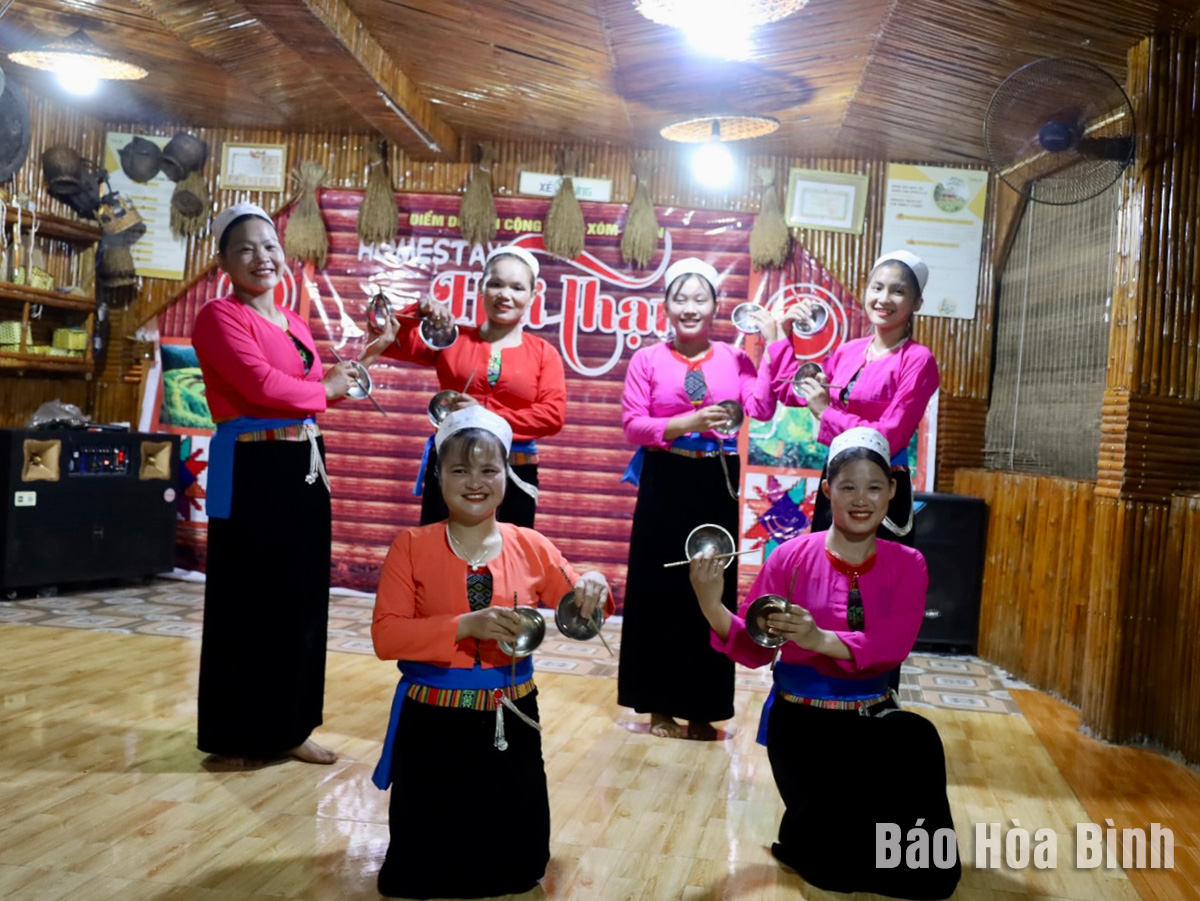
Traditional cultural values of Muong people have been preserved well in Chien hamlet, Van Son commune, Tan Lac district.
Located about 4 km away from the commune’s centre and at an altitude of 800 m above sea level, Chien hamlet is known as a peaceful and beautiful Muong village.
Villagers in Chien hamlet perform a Muong dance to serve tourists at Hai Than homestay.
Visitors to Chien hamlet are much impressed by the simple beauty of the stilt houses in a spacious highland scenery and the hospitality of local villagers. Tran Tuan Viet, a tourist from Hanoi said that local people are so friendly and sociable. During his two-day stay in the hamlet, he enjoyed the fresh air, explored Nam Son cave, contemplated three ancient lychee trees, and particularly he had a chance to try delicious local food.
In 2019, Chien hamlet received financial support from the Australian Foundation for the Peoples of Asia and the Pacific to implement the project "Improving Sustainable Livelihoods through Community-based Tourism Development". Under the project, three households in the hamlet were chosen to develop homestay services namely Hai Than, Xuan Truong, and Thu Bi homestays.
Doing community-based tourism, villagers are engaged more in preserving cultural identities to create attractive products to visitors. Ha Van Hun, Secretary of the Chien hamlet Party cell, said that the hamlet is home to nearly 80 households with about 400 people, most of them are from the Muong ethnic group. Local people mostly do farming work.
Since the community-based tourism model was developed in the hamlet, local people have paid more attention to promoting cultural identity, especially in communications, customs, and costumes. They also care more about protecting the environment and keeping village roads/alleys bright and clean.
Being formed later than other community tourism destinations in the district and province, Chien hamlet quickly became one of the most popular tourist destinations thanks to its advantages in weather and culture.
Coming to the hamlet, tourists can visit the national scenic spot Nam Son cave, the relic site of Nui Kien cave, and learn about biodiversity and natural landscapes. The hamlet is also home to a vast ancient tangerine hill which turns more attractive during harvest season at the end of the year.
Visitors can also explore the Van Son market fair, which takes place every Tuesday and offers agricultural products such as Bac Son purple garlic, Quyet Chien off-season vegetables and fruits, herbs, wild bamboo shoots, tea, chicken, Ngo Luong native pig, and Huop Lung Van wine.
With an increasingly vibrant and widespread emulation movement aimed at building cultured residential areas and cultured families, Yen Thuy District has been making steady progress toward improving both the material and spiritual well-being of its people, while fostering a civilized, prosperous, beautiful, and progressive community.
Once lacking recreational spaces and community facilities, Residential Group 2 in Quynh Lam Ward (Hoa Binh City) has recently received attention for the construction of a new, spacious, and fully equipped cultural house. The project followed the model of state support combined with public contributions in both labor and funding.
The "All people unite to build cultural life" movement, which has been effectively integrated with Kim Boi district’s socio-economic development goals, is fostering a lively spirit of emulation across local residential areas, hamlets, villages, public agencies, and enterprises. In addition, through the initiative, traditional cultural values are being preserved and promoted, while community solidarity and mutual support in poverty reduction and economic development are being strengthened.
A working delegation of the Hoa Binh provincial People’s Committee led by its Permanent Vice Chairman Nguyen Van Toan on June 11 inspected the progress of a project to build the Mo Muong Cultural Heritage Conservation Space linked to tourism services in Hop Phong commune, Cao Phong district.
Born and growing in the heroic land of Muong Dong, Dinh Thi Kieu Dung, a resident in Bo town of Kim Boi district, in her childhood was nurtured by the sweet lullabies of her grandmother and mother. These melodies deeply imprinted on her soul, becoming an inseparable part of her love for her ethnic group's culture. For over 20 years, this love for her hometown has driven Dung to research, collect, and pass down the cultural values of the Muong people to future generations.
In the final days of May, the Ethnic Art Troupe of Hoa Binh Province organized performances to serve the people in remote, mountainous, and particularly disadvantaged areas within the province. These were not just ordinary artistic shows, but they were the meaningful journeys aimed at spreading cultural values, enhancing the spiritual life of the people and contributing to the preservation of ethnic minority cultural identities.



